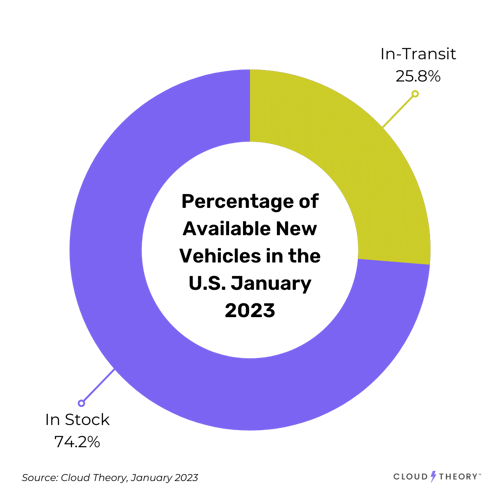Over the past year and a half, supply chain shortages have challenged new vehicle production and inventory allocation. But the automotive industry is nothing if not creative and resilient, and this situation proved to be no different. Amid the rise of "in-transit" vehicles, manufacturers and their agencies will have to monitor in-transit vs. in-stock trends and adjust accordingly. Knowing your own numbers is not enough. You need to know them for both you and your competitors in each market you serve.
Where We Were
In October 2021, new-vehicle inventory reached its lowest level in many years – at about one-third of normal counts, and it remained stuck near those low levels for the following nine months. With consumers struggling to find cars to buy, auto dealers began aggressively listing vehicles as “in-transit” to signal to consumers that vehicles were on their way. This allowed customers to buy cars before they even hit the lot, opening up possibilities for buyers and steadying or even increasing sales numbers for dealers.
In September 2022, Alexandra G. from Virginia began her search for a new car. She was looking for a certain sedan, but it was always out of stock in her area. However, she eventually found the car she was looking for through an in-transit inventory listing.
“After five months of struggling to find the car I was looking for, my local dealer listed one that was on the way to the lot, and I was able to buy it before it arrived, guaranteeing I ended up with my dream car,” she says.
Where We Are Now

Now, over one quarter of available inventory is listed as "In-Transit" nationwide. For OEMs and their affiliates, knowing the share of inventory that is in-transit vs. in stock for both you and your competitors is crucial. This information paints a much clearer picture of where you stand in your market and helps inform your decisions around where to allocate inventory.
As 2022 progressed and reached its end, new vehicle inventory on dealer lots gradually increased, but Cloud Theory observed that the use of “in-transit” inventory has continued to play a major role in how vehicles are being made available to consumers. We wanted to learn more, so we analyzed data over the past six months regarding the impact of this shift in the marketplace.
First, we found that new vehicle inventory levels available on dealer websites have increased 61% from July 2022 to January 2023, and of this increase, 68% is attributable to in-transit vehicles. This shows that in-transit inventory is not going anywhere, and it is continuing to grow as inventory rises.
In-transit vehicles are also selling well. In January 2023, 40% of the vehicles listed as in-transit were sold, demonstrating that pent-up demand still exists in the marketplace. And when compared to vehicles already on the lot, in-transit vehicles are selling more quickly than in-stock vehicles – an indication that consumers are taking full advantage of this greater availability by anticipating and acting upon a vehicle’s arrival rather than hoping that one will be at the dealer when they are there.
“I bought a car before it got to the dealer because it guaranteed that I could get the exact model I wanted. I would rather wait a little while to receive the right car than continue searching on dealer lots, only for them to tell me the car has already sold,” says Alexandra.
The use of in-transit inventory listings makes it easier for consumers to get the cars they want and gives dealers the ability to sell more vehicles. As the in-transit inventory trend continues, Cloud Theory will be monitoring it 24/7 and reporting important findings.
Interested in seeing how your inventory compares to your competitors?





